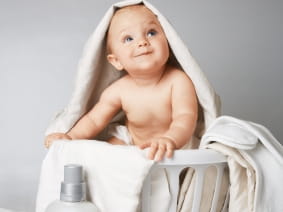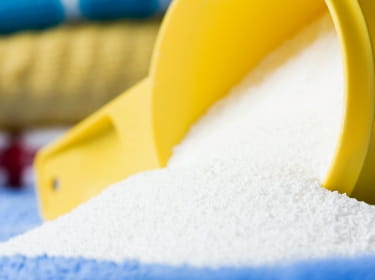Children and Laundry Products

The Bottom Line
Children get into all kinds of home laundry products. Some can cause irritation, from mild to painful: stain removers, pre-treatment agents, liquid and powder detergents, and fabric softeners. A few can cause burns or even death, such as rust remover and laundry pods. Bleach generally causes mild effects except for newer, concentrated bleach products.

Children get into all kinds of home laundry products: detergent, bleach, stain remover, fabric softener, pre-treatments, dry cleaning kits, rust removers, and so on. Some of these products can burn the mouth, eyes, or skin. Many can cause irritation. Individual laundry pods have even been associated with fatality. Whether a child will have problems depends on the exact product and what the child did with it. Here is a run-down of common laundry products - and why they should be stored up high, out of children's reach.
- Rust remover is the least common but most dangerous laundry product. Rust removers often contain strong acids that can cause eye, skin, and mouth burns on contact. A few rust removers contain hydrofluoric acid, an especially harmful poison. It can be absorbed through the skin and cause severe pain, tissue damage, and even death!
- Other types of stain removers and pre-treatment agents contain a variety of ingredients. Some can cause a bit of irritation, while others can cause more serious irritation or a painful rash. Often, the packaging limits the amount a child can get at one time.
- Detergents can cause mouth, skin, or eye irritation. This is true for liquid and dry detergents. Serious injuries are not common from liquid and dry detergents but can occur. Laundry detergent pods are different: biting into one can cause serious injury or even death.
- Fabric softeners contain some of the same chemicals as detergents. Mouth, skin, or eye irritation is possible if a child swallows or splashes fabric softener.
- Bleach has a bad reputation that is not entirely deserved. Swallowing small amounts of bleach might cause mouth irritation and vomiting. More serious problems are unlikely unless someone swallows a large amount of bleach; children usually don't do that. Splashing bleach might cause minor skin irritation. A serious rash could occur with long skin contact, for example, a child sitting in a puddle of bleach. Newer types of high-strength bleach can cause serious burns.
- Home dry cleaning kits contain a pre-treatment chemical, similar to laundry pre-treatment/stain remover products. The packaging will determine how likely it is for a child to swallow the product. Other chemicals in home dry cleaning kits are embedded in solid objects and so wouldn't be swallowed by a child.
Prevent poisonings by storing laundry products out of sight and reach of children. Also, keep products in their original containers. Countless children (and adults!) have swallowed bleach from a cup, thinking it was water. Pouring bleach into a cup, then leaving it on the counter or washing machine, is an invitation to poisoning.
If a child gets into a laundry product, here's what to do:
- If the product is in the eyes or on the skin, flush with running water for at least 15 minutes, then use the webPOISONCONTROL® online tool for guidance or call Poison Control at 1-800-222-1222. Both of these options (calling or using the online tool) will tell you exactly what to do. Most of the time, the incident can be managed at home if you contact Poison Control right away.
- If the product is swallowed, give a small amount of water or milk. Then use the webPOISONCONTROL online tool for guidance or call Poison Control at 1-800-222-1222. Both resources can help with common scenarios like:
- My child drank bleach (like Clorox). What should I do? Is it poisonous?
- My child bit a laundry pod (such as TidePods, Allmighty pacs, Purex UltraPacks, Gain flings). Is it dangerous? Should I take him to the emergency room?
- My child ate a fabric softener sheet or a dryer sheet (such as Bounce or Snuggle).
- My child drank a fabric softener (such as Downy, Snuggle, Gain, Final Touch, Purex).
- My child swallowed laundry detergent (for example, All, Tide, Purex, Arm & Hammer, Wisk, Sun, Oxi, Persil, Xtra, Cheer).
Take-Home Messages:
- Children get into all kinds of home laundry products. Some cause mild irritation, but a few can cause burns or even death.
- Rust removers containing hydrofluoric acid is extremely dangerous, whether swallowed or splashed.
- Laundry pods can cause serious injury and have been associated with fatal effects.
- Bleach generally causes mild effects except for the newer, concentrated bleach products. These can cause more serious injury.
- A number of products can cause irritation, ranging from mild to painful: stain removers and pre-treatment agents, liquid and powder detergents, and fabric softeners.
Rose Ann Gould Soloway, RN, BSN, MSEd, DABAT emerita
Clinical Toxicologist
Poisoned?
Call 1-800-222-1222 or
Prevention Tips
- Store laundry products out of sight and reach of children.
- Keep products in their original containers.
This Really Happened
Case 1: A 40-year-old woman tried to remove a clothing stain using bleach and an extra-strength laundry stain remover without success, so she applied a rust remover containing hydrofluoric acid (HFA) with bare hands. She used her knuckles to rub the products into the fabric. She developed pain, swelling, redness and brown spots on one hand despite washing well with warm water. Two hours after using the rust remover, she called Poison Control and was advised to be evaluated in the nearest emergency room due to the potential of HFA to cause serious, deep burns, heart rhythm problems, and other serious toxicity. Poison Control advised the emergency physician to treat the burn with topical calcium gel for 4 hours; they also told him how to prepare the mixture using ingredients already in the emergency room. The patient's EKG and blood work were normal and she was discharged to home after the topical calcium treatment and several hours of observation. The following day she woke up with brown spots and bleeding on the other hand also; she was seen by a plastic surgeon who did a calcium rinse of the affected areas and prescribed a calcium solution for home soaking.
Case 2: A 20-month-old boy swallowed a small quantity of liquid laundry detergent and vomited once shortly after. His mom gave him water and milk to drink; he then appeared to be fine. She called Poison Control an hour later and was reassured that an episode of vomiting was expected but no further problem was likely. Poison Control advised the child's mom to call back with any further concerns.
For More Information
Doing laundry safely (American Cleaning Institute)References
Bateman DN. Household products. Medicine. 2011;40:125-6.
Heppner J, Bohra R. Household "hazmat": A pair of SUDSy Siblings. Pediatric Emergency Care. 2013; 29:773-7.
McKenzie LB, Ahir N, Stolz U, Nelson NB. Household cleaning product-related injuries treated in US emergency departments in 1990-2006. Pediatrics. 2010;126:509-516.
Poisoned?
Call 1-800-222-1222 or
Prevention Tips
- Store laundry products out of sight and reach of children.
- Keep products in their original containers.
This Really Happened
Case 1: A 40-year-old woman tried to remove a clothing stain using bleach and an extra-strength laundry stain remover without success, so she applied a rust remover containing hydrofluoric acid (HFA) with bare hands. She used her knuckles to rub the products into the fabric. She developed pain, swelling, redness and brown spots on one hand despite washing well with warm water. Two hours after using the rust remover, she called Poison Control and was advised to be evaluated in the nearest emergency room due to the potential of HFA to cause serious, deep burns, heart rhythm problems, and other serious toxicity. Poison Control advised the emergency physician to treat the burn with topical calcium gel for 4 hours; they also told him how to prepare the mixture using ingredients already in the emergency room. The patient's EKG and blood work were normal and she was discharged to home after the topical calcium treatment and several hours of observation. The following day she woke up with brown spots and bleeding on the other hand also; she was seen by a plastic surgeon who did a calcium rinse of the affected areas and prescribed a calcium solution for home soaking.
Case 2: A 20-month-old boy swallowed a small quantity of liquid laundry detergent and vomited once shortly after. His mom gave him water and milk to drink; he then appeared to be fine. She called Poison Control an hour later and was reassured that an episode of vomiting was expected but no further problem was likely. Poison Control advised the child's mom to call back with any further concerns.
